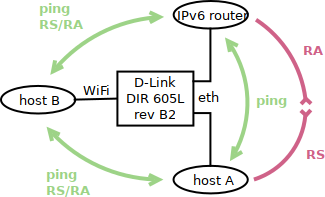Today I tried to configure a stub-zone on a unbound resolver. This was for the reverse resolution of some private IPv6. In unbound.conf, it looks something like this:
stub-zone:
name: X.X.X.X.X.X.d.f.ip6.arpa.
stub-addr: {authoritative-server-ip}
But trying a reverse resolution on any of those private IPv6 failed:
$ drill -x fdXX:XXXX::XXXX ;; AUTHORITY SECTION: d.f.ip6.arpa. 10800 IN SOA localhost. nobody.invalid. 1 3600 1200 604800 10800
Found out the problem in a snippet from unbound.conf.sample:
# By default, for a number of zones a small default 'nothing here' # reply is built-in. Query traffic is thus blocked. If you # wish to serve such zone you can unblock them by uncommenting one # of the nodefault statements below. # You may also have to use domain-insecure: zone to make DNSSEC work, # unless you have your own trust anchors for this zone. # local-zone: "localhost." nodefault # local-zone: "127.in-addr.arpa." nodefault # local-zone: "1.0.0.0.0.0.0.0.0.0.0.0.0.0.0.0.0.0.0.0.0.0.0.0.0.0.0.0.0.0.0.0.ip6.arpa." nodefault # local-zone: "home.arpa." nodefault # local-zone: "resolver.arpa." nodefault # local-zone: "service.arpa." nodefault # local-zone: "onion." nodefault # local-zone: "test." nodefault # local-zone: "invalid." nodefault # local-zone: "10.in-addr.arpa." nodefault # local-zone: "16.172.in-addr.arpa." nodefault # local-zone: "17.172.in-addr.arpa." nodefault # local-zone: "18.172.in-addr.arpa." nodefault # local-zone: "19.172.in-addr.arpa." nodefault # local-zone: "20.172.in-addr.arpa." nodefault # local-zone: "21.172.in-addr.arpa." nodefault # local-zone: "22.172.in-addr.arpa." nodefault # local-zone: "23.172.in-addr.arpa." nodefault # local-zone: "24.172.in-addr.arpa." nodefault # local-zone: "25.172.in-addr.arpa." nodefault # local-zone: "26.172.in-addr.arpa." nodefault # local-zone: "27.172.in-addr.arpa." nodefault # local-zone: "28.172.in-addr.arpa." nodefault # local-zone: "29.172.in-addr.arpa." nodefault # local-zone: "30.172.in-addr.arpa." nodefault # local-zone: "31.172.in-addr.arpa." nodefault # local-zone: "168.192.in-addr.arpa." nodefault # local-zone: "0.in-addr.arpa." nodefault # local-zone: "254.169.in-addr.arpa." nodefault # local-zone: "2.0.192.in-addr.arpa." nodefault # local-zone: "100.51.198.in-addr.arpa." nodefault # local-zone: "113.0.203.in-addr.arpa." nodefault # local-zone: "255.255.255.255.in-addr.arpa." nodefault # local-zone: "0.0.0.0.0.0.0.0.0.0.0.0.0.0.0.0.0.0.0.0.0.0.0.0.0.0.0.0.0.0.0.0.ip6.arpa." nodefault # local-zone: "d.f.ip6.arpa." nodefault # local-zone: "8.e.f.ip6.arpa." nodefault # local-zone: "9.e.f.ip6.arpa." nodefault # local-zone: "a.e.f.ip6.arpa." nodefault # local-zone: "b.e.f.ip6.arpa." nodefault # local-zone: "8.b.d.0.1.0.0.2.ip6.arpa." nodefault # And for 64.100.in-addr.arpa. to 127.100.in-addr.arpa.
As you can see d.f.ip6.arpa. is blocked by default, so just had to add this line to unblock it:
local-zone: "d.f.ip6.arpa." nodefault

